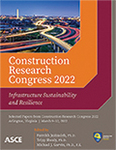Transportation Asset Data Management: BIM as a Holistic Data Management Approach
Publication: Construction Research Congress 2022
ABSTRACT
Departments of Transportation (DOTs) are responsible for managing and maintaining transportation assets in the US. DOTs manage a wide variety of assets throughout their lifecycle, including high-value assets such as pavements and bridges, in addition to a wide variety of ancillary assets. Managing transportation assets with declining funding and deteriorating infrastructure conditions requires that DOTs have reliable and useful quality data to make better decision-making and efficient capital investments. However, they are still facing challenges in collecting, managing, and sharing transportation asset data. By conducting a comprehensive review of the DOTs’ current practices in managing their transportation asset data, used technologies to assist in managing asset data, challenges faced, and addressed efforts to pass those challenges were extracted and grouped into six major data management practices. Furthermore, this paper investigated the possibility of implementing Building Information Modeling (BIM) as a hub that allows for a seamless asset data management approach.
Get full access to this article
View all available purchase options and get full access to this chapter.
REFERENCES
Abdal Noor, B., and Yi, S. (2018). “Review of BIM literature in construction industry and transportation: meta-analysis.” Construction Innovation, 18(4), 433–452.
Abdirad, H., and Dossick, C. S. (2020). “Rebaselining Asset Data for Existing Facilities and Infrastructure.” Journal of Computing in Civil Engineering, 34(1), 05019004.
Allen, B. W., Ram, P., Koonce, J., Raj, D., Burns, S., Zimmerman, K. A., Smadi, O. G., and Mugabe, K. (2019). Handbook for Including Ancillary Assets Transportation Asset Management Programs. United States. Federal Highway Administration. Office of Research, Development, and Technology.
AASHTO. (2020). Transportation Asset Management (TAM) Guide. <https://www.tamguide.com/>.
UDOT (Utah Department of Transportation). (2020). Digital Delivery of Model-Based Design and Construction: THE UDOT EXPERIENCE. <https://construction.transportation.org/wp-content/uploads/sites/20/2020/08/Utahs-experience-with-tools-to-visualize-the-3D-model-in-the-field.pdf≥.
FHWA (Federal Highway Administration). (2012). Civil Integrated Management (CIM) <http://flh.fhwa.dot.gov/innovation/dv/documents/CIM-Poster-04.12.pdf >.
FHWA (Federal Highway Administration). (2019). Asset Management <https://www.fhwa.dot.gov/asset/plans.cfm>.
FHWA/AASHTO (Federal Highway Administration/ American Association of State Highway Transportation Officials). (2020), Transportation Asset Management Webinar Series, Webinar 42 TAM, and BIM, February 19, 2020. <https://www.tam-portal.com/wp-content/uploads/2020/02/tam-webinar-42.pdf>.
Gallaher, M. P., O’Connor, A. C., Dettbarn, J. L., Jr., and Gilday, L. T. (2004). Cost Analysis of Inadequate Interoperability in the U.S. Capital Facilities Industry (NIST GCR 04-867; p. NIST GCR 04-867). National Institute of Standards and Technology.
Gong, J., Zhou, H., Gordon, C., and Jalayer, M. (2012). “Mobile terrestrial laser scanning for highway inventory data collection”. Computing in Civil Engineering. 545–552.
Guo, F., Jahren, C. T., and Turkan, Y. (2019). “Electronic Document Management Systems for the Transportation Construction Industry”. International Journal of Construction Education and Research, 1–16.
Harrison, F., Duke, W., Huey, D., and Harman, C. (2020). Guidebook for Data and Information Systems for Transportation Asset Management. Transportation Research Board.
Heaton, J., and Parlikad, A. K. (2019). “A conceptual framework for the alignment of infrastructure assets to citizen requirements within a Smart Cities framework.” Cities, 90, 32–41.
Jones, S., Laquidara-Carr, D., Lorenz, A., Buckley, B., and Barnett, S. (2017). The business value of BIM for infrastructure 2017.
Le, T., Le, C., and David Jeong, H. (2018). “Lifecycle data modeling to support transferring project-oriented data to asset-oriented systems in transportation projects”. Journal of Management in Engineering, 34(4), 04018024.
Lefler, N. X. (2014). Roadway Safety Data Interoperability Between Local and State Agencies. Transportation Research Board.
Lodgher, A., Perkins, J. A., Yang, Y., Jones, E., and Hawkins, H., Jr. (2010). Feasibility and applications of RFID technologies to support right-of-way functions: Technical report. Texas Transportation Institute.
Love, P. E. D., Liu, J., Matthews, J., Sing, C.-P., and Smith, J. (2015). “Future proofing PPPs: Life-cycle performance measurement and Building Information Modelling.” Automation in Construction, 56, 26–35.
Love, P. E. D., Zhou, J., Edwards, D. J., Irani, Z., and Sing, C.-P. (2017). “Off the rails: The cost performance of infrastructure rail projects.” Transportation Research Part A: Policy and Practice, 99, 14–29.
McGuire, M., Rys, M. J., and Rys, A. (2016). A study of how unmanned aircraft systems can support the Kansas Department of Transportation’s efforts to improve efficiency, safety, and cost reduction. Kansas. Dept. of Transportation. Bureau of Research.
Ravani, B., Dart, M., Hiremagalur, J., Lasky, T. A., and Tabib, S. (2009). Inventory and assessing conditions of roadside features statewide. Advanced Highway Maintenance and Construction Technology Research Center. California State Department of Transportation.
Singh, R. (2008). Engineering automation: Key concepts for a 25-year time horizon. Oregon Department of Transportation, Highway Division.
Yates, N. J. (2009). Furthered Implementation of Long-Range RFID Technology in Highway Asset Management. Master of Science Thesis, Virginia Polytechnic Institute and State University, Virginia.
Yuan, C., McClure, T., Cai, H., and Dunston, P. S. (2017). “Lifecycle Approach to Collecting, Managing, and Sharing Transportation Infrastructure Asset Data”. Journal of Construction Engineering and Management, 143(6), 04017001.
Yuan, C., McClure, T., Dunston, P. S., and Cai, H. (2016). “Survey on the Practice Hurdles in Collecting, Managing, and Sharing Transportation Infrastructure Asset Data”. Construction Research Congress, 1648–1657.
Zhang, Z., Hamledari, H., Billington, S., and Fischer, M. (2018). “4D beyond construction: spatio-temporal and life-cyclic modeling and visualization of infrastructure data.” Journal of Information Technology in Construction, 23, 285–304.
Information & Authors
Information
Published In
History
Published online: Mar 7, 2022
Authors
Metrics & Citations
Metrics
Citations
Download citation
If you have the appropriate software installed, you can download article citation data to the citation manager of your choice. Simply select your manager software from the list below and click Download.
